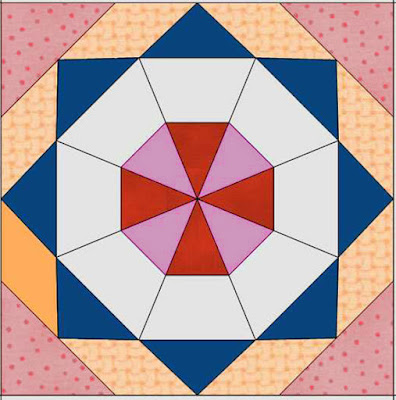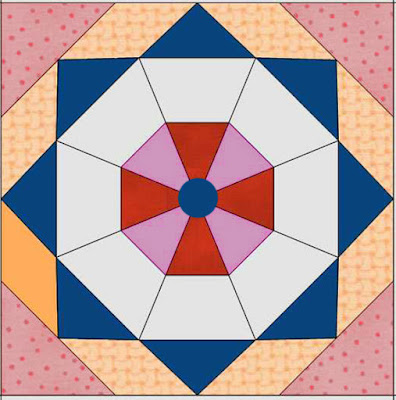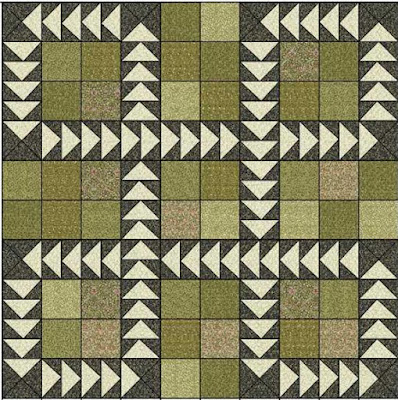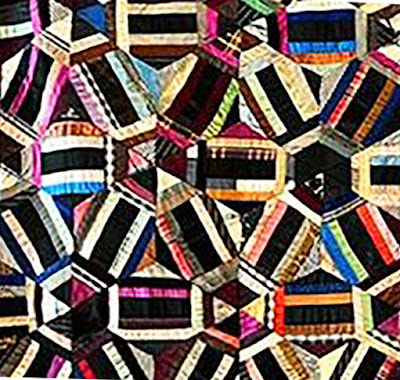Cotton yardage printed for the 1840 campaign of Whig
candidate William Henry Harrison
Library of Congress
That 1840 presidential campaign is acknowledged as the beginning of the trend for political baubles, ornaments and souvenirs. Rivals were Democrat incumbent Martin Van Buren (who ignored the trend and lost) and Harrison.
Sandwich glass plate, 1840
Whose campaign made the most of baubles.
As the voting franchise widened to include non-property owning white men (no women), campaign managers realized that objects could simplify the message and establish the brand. Politicos expanded that appeal to women with material goods like china and the fabric above.
Pook & Pook Auction
Brown colorway of the Harrison print between
the four-patches.
Collage by Donna Segar at Streets of Salem
The monochromatic yardage with a portrait of the candidate must have been popular.
Many fragments in three colorways and a few quilts survive.
Two different Harrison fabrics were printed.
Textile Museum of Canada
The second multicolored print has no portrait but a log cabin with
cider barrels, eagles and a pair of cannon.
Western Kentucky University Collection
Patchwork quilt from Suffolk County, Long Island that passed from
20th-century dealer Florence Peto to Elizabeth Richardson. The cannon
print is on three borders.
The New England Quilt Museum owns a wholecloth
quilt that once belonged to political collector Julie Powell.
The cannon print seems to have been less available than the monochromatic
portrait print as fewer pieces survive.
Flag for the hero of an 1811 battle with the indigenous Ohioans.
The marketing message was simple. Winning a battle was the ultimate qualification
for political office.
Alternate message: He was a man of the people, those yeoman
farmers exercising their right to vote.
Poor President Harrison, "Old Tippecanoe," died of
a fever 3 weeks after his inauguration. They'll tell you he caught
his death from the cold at the ceremony where he refused to wear a hat
but it was probably White House sanitation that did him in.
Mourning lithograph, 1841
We would expect to find quilts in patterns advocating Harrison's election in 1840 such as the three pieced of yardage above. The early 1840s, however, was a time of other innovations. After Harrison's death quilts especially album quilts became quite the fashion. Applique blocks were designed in wide profusion, no where more cleverly than in Baltimore.
2010 Sale catalog
The symbolism is easily readable. Harrison, the log cabin candidate, was not too aristocratic for a barrel of hard cider. (Van Buren allegedly preferred champagne.) Whigs were symbolized by the racoon on the roof; Democrat Van Buren symbolized perhaps by the fox under the flag.
These appliqued log cabins with their animal mascots, however,
date from years after Harrison's death in April, 1841.
National Museum of American History
Top associated with Rebecca Diggs.
The distinctive style tells us they are Baltimore
Album quilts, which flourished in the years 1846 into the 1850s.
The barrel is inked Hard Cide(r).
These appliqued log cabins must be commemorative rather than campaign blocks or perhaps political in alluding to the sainted predecessor of 1844's Whig Candidate Henry Clay.
Hard to see the print in this Flying Geese from James Julia auctions
but it may be the polychrome print with the cannons.
Van Buren, the Sly Fox being chased by dogs
wearing cider barrels.
Opponent President Martin Van Buren could not compete against the abundance of political ephemera or on his own record.
He was painted as a snobbish New Yorker.
Uncle Sam sick with La Grippe
attended by "Aunt Mattie" and his/her quacks.
The disastrous Panic of 1837 was his legacy.
And his campaign offered little appeal for the common voter (or the voter's wife.)
The Democrats disdained that "mob rule."
Heritage Auctions sold this rare Van Buren-touting banner.
It's hard to understand but the implication is that if you were persuaded to board
Tip's Canoe (Harrison) you'd sink.
Handmade decoupage bandbox with Van Buren portrait
See a post on politics from ten years ago here:






















.jpg)

































